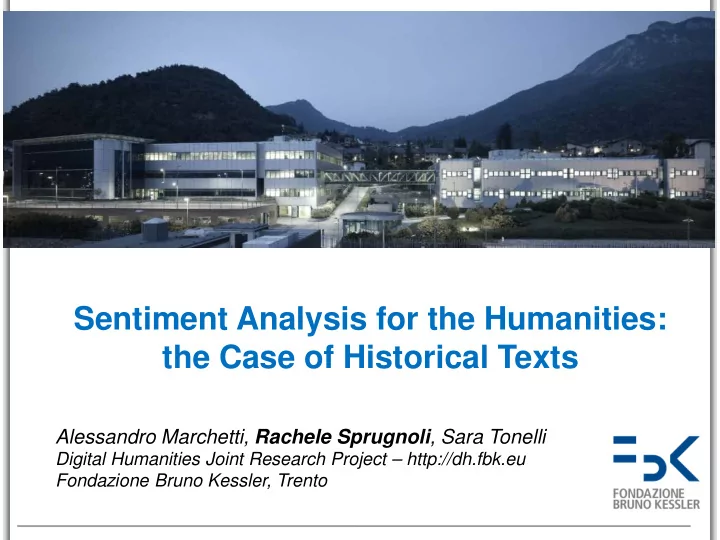

Sentiment Analysis for the Humanities: the Case of Historical Texts Alessandro Marchetti, Rachele Sprugnoli , Sara Tonelli Digital Humanities Joint Research Project – http://dh.fbk.eu Fondazione Bruno Kessler, Trento
Sentiment Analysis (SA) “Computational treatment of opinion, sentiment and subjectivity in text” Pang and Lee (2008) A popular research topic in NLP, text mining, and Web • mining in recent years Social Media News Customer Reviews
Sentiment Analysis in the Humanities Some applications on literary research: • - Kakkonen and Kakkonen (2011) - Mohammad (2011) - Heuser and Le-Khac (2012) SentiProfiler
Sentiment Analysis in the Humanities Some applications on literary research: • - Kakkonen and Kakkonen (2011) - Mohammad (2011) - Heuser and Le-Khac (2012)
Sentiment Analysis in the Humanities Some applications on literary research: • - Kakkonen and Kakkonen (2011) - Mohammad (2011) - Heuser and Le-Khac (2012)
Prior vs. Contextual Polarity Prior r polarit rity: the sentiment a term evokes out of context Polarity lexica: each word associated with its polarity score - Positive: beautiful , amazing - Neutral: Italian , general - Negative: bad , poor Key linguistic feature of ML approaches to SA No available lexicon for Italian Con onte textu tual P Pol olarity ty: the sentiment a term evokes according to its syntactic, semantic or pragmatic context - they fought a terri errific battle - I loved the film, it was terri errific
Approaches to Polarity Assignment 1. Manual Annotation 2. (Semi-)Automatic Mapping 3. Crowdsourcing Annotation “ Crowdsour urci cing ng is a type of partic icip ipative ive onlin ine a activi ivity in which an individual, an institution, a non-profit organization, or company proposes to a group of individuals of varying knowledge, heterogeneity, and number, via a flexible op open cal all, the voluntary unde dertaking of a a ta task ” Estellés-Arolas and González-Ladrón-De-Guevara (2012)
SA on Historical Texts at FBK Part of our research on the adaptation of Human man Lang ngua uage R Resour urce ces and T Techn chnologies to texts of late- modern and contemporary history Collaboration with the Italian-German Historical Institute in Trento SA has been identified as notably relevant to: - quantify the genera ral l sentim iment of single document - allow searc rch based on sentiment - track the attitude towards a specific con oncept t or or en entity o over t er time ime
SA on Historical Texts at FBK To be integrated in ALCIDE (Anal alysis o of Lan anguage an and d Content I In a a Digital E l Enviro vironment) Case Study: Complete collection of Alc lcid ide De De Ga Gasp speri’s writings - 3K documents - 3million words - 1901 – 1954 FIRST S STEP: 2 : 2 experim riments
Prior Polarity Experiment RESEARCH QUESTIONS: how lexical resources built on contemporary languages can deal with historical texts? - WordNetAffect, Strapparava and Valitutti (2004) - SentiWordNet 3.0, Baccianella and Sebastiani (2010)
Prior Polarity Experiment: some Numbers Lemmas in De Gasperi’s writings: 70,178 - after excluding lemmas that can’t have a polarity: 36,304 - the lexicon covers 14,874 lemmas, i.e. 40.97% 97% 14,874 lemmas out of which - 9,650 650 are neutral (score = 0) - 5,224 224 lemmas have a polarity score: - 449 with an absolute positive score (score = 1) e.g. ‘eccellente'/ excellent - 576 with an absolute negative score (score = -1) e.g. 'affranto'/ broken-hearted - the others with intermediate scores e.g. ‘intellettuale' /intellectual score = 0.875
Prior Polarity Experiment: visualization
Prior Polarity Experiment: visualization
Prior Polarity Experiment: document aggregation Sentiment of De Gasperi’s writings dated back to 1914 and • related to the outbreak of WW1 Wor ords wit ith negat ative e prio rior p r pola larity
Prior Polarity Experiment: document aggregation Sentiment of De Gasperi’s writings dated back to 1914 and • related to the outbreak of WW1 Word rds wit ith posit itiv ive p prio rior pola larity
Crowdsourcing Experiment: Contextual Polarity RESEARCH QUESTIONS: Is it possible to apply crowdsourcing methodologies to the assignment of contextual polarity in historical texts? EXPERIMENT: 2 lemmas ‘sindacato’ ( trade-union ) and ‘sindacalismo’ ( trade-unionism ) 525 sentences 2 expert annotators judged the contextual polarity third judgment collected through a CrowdFlower job: quality control mechanisms: - regional qualifications - gold units - majority vote on 5 judgments
Crowdsourcing Experiment: Job Interface
Crowdsourcing Experiment: Results At the end: - 21 contributors, out of which only 12 were reliable - 5 days to complete the job - 36 $ total cost of the experiment ACCURA RACY CY Prior polarity of the sentence based on the lexicon
Crowdsourcing Experiment: Results IN INTE TER-ANN NNOT OTATOR OR A AGREEM EMENT ENT
Conclusions new Italian lexical resource for SA eccellente a#02232109 1 0 of the highest quality; measurement and visualization of polarity at document level integrated in ALCIDE standard crowdsourcing methods used in other domains cannot be straightforwardly adopted to historical texts
Future Works From document level to concept-based / entity-based SA - De Gasperi on corporatism before and after 1946 - De Gasperi on Togliatti in propaganda vs Parliament speeches Extend SA to English texts - Next case study: 1960 USA Presidential campaign speeches Improve visualization: It's a rule in Digital Humanities: you need an Italian designer in your project Bruno Latour
THANK YOU! Email: sprugnoli@fbk.eu Web Site: http://dh.fbk.eu Twitter: https://twitter.com/DH_FBK
Recommend
More recommend